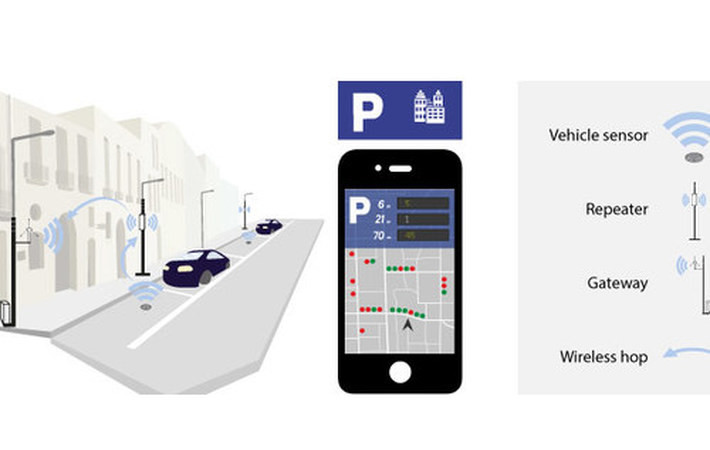
Published on 12/06/2016 | Use Cases
THOSE HATED PARKING INSPECTORS are getting smarter. Around the world, car parking bays are being upgraded with in-ground sensors that record the time a vehicle enters, alerting parking inspectors via the 'Internet of Things' (IoT) the second a vehicle overstays the posted period. Great news for a city's revenue targets. Bad news for us.
Or is it?
That same sensor that indicates whether a parking bay is occupied is also able to inform a drivers' mobile phone of a vacant space up ahead. Tinynode, a Swiss company, says that drivers in cities spend between 20 to 60 percent of their driving time randomly looking for a parking space. The company is one of many IoT sensor developers that are embracing the convergence of cheap computing power, IoT sensors, and mobile phone ubiquity, in this case to help drivers reduce wasted time and frustration.

Image: Tinynode website
All this IoT technology is possible, because the price of sensors, like those embedded into Tinynode products, have declined by 50% over the past decade. Prices, due to economies of scale and digital electronic printing, are dropping so fast in fact that a sensor that cost $1.30 in 2004 will cost on average 38 cents by 2020. In short, 'cost' will no longer be a limitation to adding IoT functionality to virtually anything, even disposables.
Cambridge masks, a company founded by Beijing-based British expat Christopher Dobbing, is planning to launch an IoT enabled variation of their already popular disposable pollution mask. Aside from the regular health conscious consumers, Dobbing is targeting employers who want to ensure that their workers are always wearing a mask when outside in China's notorious dirty air. Eighteen months ago, the embedded IoT sensor within the mask was $22, but now that same microchip, the Nordic Bluetooth low energy IC, has dropped dramatically to just over $1, making the disposable 'smart mask' financially viable.
This is great news for those with a car and disposable income. For others in developing countries, however, IoT is becoming integrated into the necessities, namely water. In Kenya and Uganda, Grundfos, a Danish pump manufacturer, is using IoT to increase the reliability, potability and affordability of water, through water ATMs.
Informal settlements, that have spontaneously built-up due to the increased migration of the rural population to urban areas, were previously at the mercy of 'water middlemen'. Grundfos, through it's Lifelink Water Solutions division, have created transparency between the water utility and the consumer. Their solution is the AQtap, an IoT water dispenser that is accessed via a WaterCard - an RFID smart card connected to a customer's mobile phone account. Every AQtap, and there's approximately 100 spread across the two countries, then communicates back to the central Water Management System, that keeps track of all water and credit transactions, which in turn helps to monitor the status of each AQtap unit, predict servicing requirements, and ultimately increase the health and wellbeing of millions.
Considering the term, 'The Internet of Things', was only mentioned in mainstream media in 2003 and became officially 'born' in 2008, it's incredible how quickly this unstructured technology has infiltrated the industrial, commercial and consumer markets. The world has truly embraced IoT 'sensor-ship', but, at the same time, it must also be cautious. In October of this year, multiple Distributed Denial of Service (DDoS) attacks were made possible by the millions of unsecured home routers, digital video recorders and surveillance cameras, connected via IoT. The attackers employed thousands of these devices by infecting each with malicious code to form a botnet, which in turn disrupted the websites of Twitter, Pinterest, PayPal, amongst many others.
This is the dark side of IoT, and a reminder that technology is never neutral. One man's vacant parking bay is another man's parking fine. It just depends on who is holding the technology.
This article was originally posted on LinkedIn.